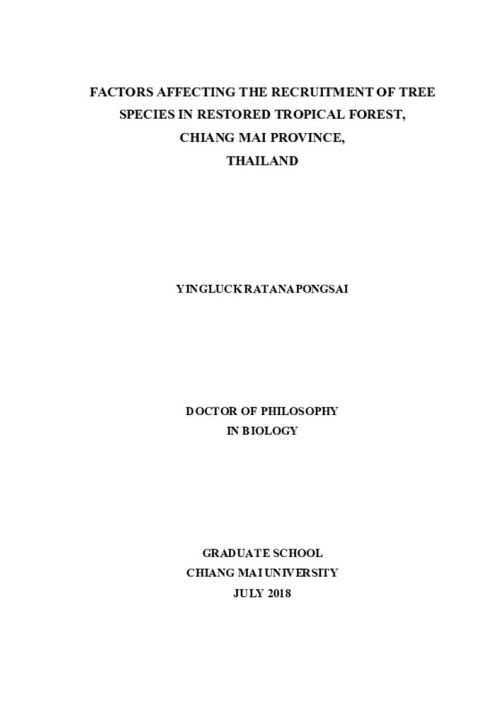Factors Affecting the Recruitment of Tree Species in Restored Tropical Forest, Chiang Mai Province, Thailand

FORRU Contributors
Abstract: FORRU-CMU has been developing and adapting the framework species method of forest restoration (FWS) to restore tropical forest ecosystems to degraded forest land in northern Thailand, since 1994. The technique accelerates natural forest succession by selecting tree species that attract seed-dispersing animals and create conditions conducive for seed germination and early seedling establishment of incoming ‘recruit’ tree species. The research reported here, therefore, tested the effectiveness of the method in achieving seedling recruitment of native tree species, by field surveys of FWS plots at Baan Mae Sa Mai (BMSM). The study site consisted of FWS plots of 3 different ages: 6, 10 & 14 years since commencement of restoration activities (abbreviated to R6, R10 and R14), compared with 14-year-old natural regeneration site (control site) and old-growth, natural, remnant forest (DSF). Seedlings of native species and adult trees were systematically surveyed. Leaf area index (LAI), global site factor (GSF) and soil field capacity (FC) were also evaluated as factors likely to affect seedling recruitment and mortality rates. Fifty-one per cent of total adult species present in the vicinity of the plots (including FWS planted species) successfully recruited into the seedling communities, across all R plots. The most important limiting factor was species rarity in the surrounding area. Seed size, seed-dispersal modes and successional status of tree species did not significantly influence recruitment success or failure. After 6-14 years of restoration, the diversity of recruit species approached levels similar to those of the natural remnant forest (DSF). Seedlings of animal-dispersed species were more common and had higher recruitment rates in all R plots. The recruitment rate of seedlings of non-pioneer species was similar across all 3 ages of R plots, whilst the mortality rates of pioneer species was lower in the R6 plots than in the R10-14 plots. Density and basal area of the planted FWS trees exceeded those of naturally established trees in the DSF plots, after 6 years of restoration. Consequently, the dense forest canopy of the FWS trees reduced light availability at ground level in the R plots to levels similar to those in the DSF plots. However, soil moisture-holding capacity (per cent moisture at field capacity, FC) of all the R plots was lower than that of the DSF plots. Both tree BA and light conditions strongly influenced recruitment and mortality rates of both pioneer and non-pioneer tree seedling species. Low LAI and BA of understorey trees in the R forests supported recruitment of seedlings of non-pioneer species, whilst low GSF and high BA of canopy trees decreased seedling recruitment of pioneer species. Conditions in R6 were more favourable for pioneer species establishment than they were in older plots. Forest structure of in the natural regeneration control plots (after 14 years) was poorly developed. Large-seeded spices failed to recruit into such plots. Better conditions for seedling establishment occurred along the R14-control plot boundaries.
The FWS technique efficiently accelerated forest habitat recovery and native species recruitment, compared with DSF and the control, natural regeneration, sites. The FWS trees were well develop, providing shady habitat for tree seedling establishment and showing signs of catalyzing habitat recovery beyond the plot boundaries. However, further study of soil FC improvement is recommended since its recovery after 14 years was unexpectedly slow. Indigenous tree species that are absent or rare in the surrounding landscape should be included in FWS plantings, to enhance diversity, since they are unlikely to recruit without intervention. A combination of several restoration methods might help researchers overcome site limitations and accelerate forest recovery for larger landscapes.

